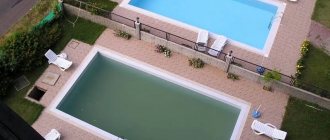Pros and cons of water heaters
The benefits of using gas pool water heaters include the following:
- high efficiency and heating speed;
- ability to work autonomously;
- absence of combustion products;
- simple operation;
- wide selection of models.
Disadvantages of the device:
- the need for a constant gas supply of acceptable pressure;
- constant monitoring of gas leaks;
- strict requirements for the room where the device is installed;
- complexity of connection (services of qualified specialists are required);
- the need for professional service;
- regular monitoring of equipment performance.
Design and principle of operation
The gas burns in the heater, releasing heat, which is transferred to the water passing through the circuit of the device.
The heat exchange device does not heat the water directly. This is an optimization element that increases the efficiency of heat exchange between 2 media: water in the pool and coolant operating from a heat source.
Inside the heat exchanger, they are separated by a system of thin tubes or plates made of a material with high thermal conductivity. The larger the area of this contact, the greater the amount of heat that manages to move from a more heated environment to a less heated one.
A high degree of efficiency and cost-effectiveness of equipment is achieved through the use of natural fuel. The power of the gas heater starts from 115 kW. Propane ensures stable maintenance of a comfortable water temperature for a long period of time.
The best manufacturers
Before buying a VB in an online store, you need to determine which model from which company will perform its functions better. In this matter, recommendations from the owners of such equipment will be a good help. In most cases, they advise purchasing devices from the most well-known companies. They always have good performance characteristics and function reliably for a long time.
The most popular manufacturers:
- Intex (Netherlands);
- TeploMax (Russia);
- Bestway (China);
- Dymoff (Russia);
- Pelletron (Russia);
- PAHLEN (Sweden).
How to choose?
Gas heaters have the following technical characteristics:
Maximum operating temperature: shows how hot the gas heater coolant can be.- Thermal power: depends not only on the contact area between the two media, but also on the type of liquid being processed.
- Throughput (measured in cubic meters per hour): this parameter shows the time during which the entire volume of water in the pool will pass through the heat exchanger.
After determining the appropriate parameters for the technical characteristics of the gas heater, the required power of this device should be calculated.
To do this, you need to take into account factors:
- pool volume;
- volume of constant heat loss;
- heat source power;
- coolant temperature;
- desired pool water temperature;
- the time period during which water needs to be heated, provided that it has just been collected.
It is advisable to select the power of the equipment corresponding to the maximum level of heat loss. This is enough to maintain an acceptable water temperature during peak loads on the system.
The rules for saving resources are also observed. The lower power limit is selected with a coefficient of 0.7 from the volume of the pool bowl.
Next, you need to calculate the acceptable power of the heat exchanger. To do this, use the formula P = ((V*C * ΔT)/t1) + q*S, where :
- P – required heat exchanger power (W),
- C – specific heat capacity of water at a temperature of 20°C (W/kg*K);
- ΔТ – difference in temperature of cold and hot water (оС),
- t1 – optimal time for heating the entire pool (hours),
- q – heat loss per hour per square meter of water surface (W/m2),
- V – volume of water in the pool (l).
The obtained result is compared with standards. For example, for an outdoor pool, the acceptable power of a gas heater is 1000 W/m2; if the pool is partially closed (a canopy or part of a building), the power should be 620 W/m2. For indoor pools, the described parameter should correspond to 520 W/m2.
An important parameter is the operating time of the heat exchanger to heat the water in the pool to the required value. The calculation is carried out using the formula t = 1.16 * V * T / P, where :
- t – required time in hours;
- V – volume of water in the pool in cubic meters;
- T – required temperature difference in degrees;
- P – declared power.
For example, the initial temperature of the water in the pool is 20 degrees Celsius. It needs to be heated to 26 degrees. The temperature difference is 6 degrees. The volume of the bowl is 30 cubic meters. A heat exchanger with a capacity of 6 kW is also installed. By calculation we get the value 34.8 hours.
Does it matter?
Heating water is a physical process that occurs under certain conditions. They can promote or hinder the heating of water, since the transfer of thermal energy is always interconnected with all surrounding objects or factors.
Bowl type
The type and design of the bowl can affect the heating mode in a very direct way. For example, the depth of the pool determines the effectiveness of heating using solar rays.
In addition, if the pool is deep, then the volume of water that needs to be heated increases. For this, more thermal energy is consumed, i.e. a higher power heater is required.
There are conventional and frost-resistant pool designs.
The former must be drained and stored indoors at the end of the swimming season (most often such models are bought for a summer residence), the latter can be left filled with water for the winter.
The walls of the bowl in frost-resistant species are more durable, assembled from several layers. They are able to resist the effects of low temperatures and frosty expansion of water.
Manufacturer
The heating method does not depend on the manufacturer (be it Intex, Bestway or any other company), since in any case there is a certain volume of water. Only the enclosure of the bowl changes, which practically does not affect the temperature inside.
Boiler models for heating water with gas, prices
Popular models of gas heaters for swimming pools are the following:
Vanward Tankless
Affordable gas pool heater made in China. Suitable for small medium bowls for home use . Compliance with ISO9001 standards certifies the high quality and safety of the product.
The compact size of the device allows it to be installed in limited spaces. The average cost of such a heater is from 15,000 to 16,000 rubles.
Volcano
Gas heaters of the Vulcan brand are compact, easy to use and efficient . Suitable for stationary, quickly installed and swimming pools.
The supply type of heater requires its connection to a water filtration system, the productivity of which should be in the range from 2 to 9 thousand liters per hour. The cost of the model is 30-35 thousand rubles.
Davey
Davey gas heaters are suitable for large-volume amateur and professional pools. They are used in SPA centers, swimming establishments and private residential properties (country houses, cottages, dachas).
HSI (hot surface ignition) technology has been introduced, which reduces fuel consumption by reducing pilot light consumption. The average cost of the model is about 220-250 thousand rubles.
How to connect to the tank?
Installation and configuration of such equipment for the pool requires highly qualified specialists. Connection is carried out in accordance with the attached instructions. In general, the connection algorithm consists of the following steps:
- Installing the heater on a flat surface near the pool.
- Connecting the hose from the filter system to the lower pipe of the heater.
- Turning on the filter system and releasing air from it.
- Connecting the reducer to the gas cylinder.
How to use?
To start heating, it is enough to provide gas supply to the device and turn on the equipment with the appropriate switch. Next, after the operating time of the heat exchanger, previously calculated by the appropriate formula, you need to check the temperature in the pool.
It should correspond to the expected value: swimming pools, sports pools - from 24 to 26 degrees Celsius, children's pools - from 28 to 30 degrees Celsius, pools for hydromassage and similar water treatments - from 32 to 38 degrees Celsius.
Basic Rules
Swimming is not only a pleasant activity - it is also very useful for the prevention and treatment of a number of diseases of the heart, lungs, and bone tissue. The main thing is to create the correct temperature regime. If the water is cold, there is a risk of relapse of chronic diseases. An excessively warm pool will not have an invigorating effect and will not tone your muscles.
The optimal water temperature for adults is 23 degrees, for children - 26.
Other methods of heating an artificial reservoir
Let's look at what devices can be used to heat the water in the pool.
Geyser
The water in the pool can be heated using a household gas water heater .
However, it must be taken into account that this method is only suitable for small-volume remote pools. They are installed on a temporary basis at dachas or on the territory of a country house.
The power of the column must be at least 20 kW. You can easily purchase such a product in any specialized store at a cost of 3 to 6 thousand rubles.
Gas cylinder
Gas can be supplied from a gas cylinder . To connect equipment to such a cylinder, you should first of all pay attention to the thread of the nut (in many heater models the nut has a left-hand thread) that secures the heater connection point. You need to screw it counterclockwise as tightly and carefully as possible.
Next, open the cylinder valve. To do this, you need to rotate it counterclockwise. At this time, you should finally make sure that there is no gas leakage from under the nut.
To make sure that gas does not flow into the burners, you need to unscrew the fuel supply control screw located on the reducer. This is also done counterclockwise until the value on the pressure gauge reaches 0 MPa. Next you need to light the burner.
Before starting you should check:
- is the water circulation turned on?
- are there any leaks;
- is a reducer connected to the cylinder;
- Is the valve open?
Ignition is carried out with a special gas lighter. This is the easiest and safest way to properly light a burner.
When turned on, it is brought to the burner and at the same time the gas supply screw is rotated clockwise. After ignition, you need to set the value to 0.1 MPa on the pressure gauge for stable operation.
Budget
The budget category of devices includes:
- boilers;
- snails;
- bedspreads;
- firewood.
Boilers
A boiler can easily heat water in a small children's pool. However, when using this method, you must follow safety rules: do not touch the water while the boiler is operating and do not lean it against the walls of the pool. As an example, to obtain the required temperature, you can simply add a little hot water.
Article on the topic: When will the swimming pool open on the blue
Snails
A homemade solar battery is called a snail. Such devices are often sold in markets at a fairly reasonable price. The snail can cope with heating quite well, but only in sunny weather.
Photos of our contractors' pools:
Bedspreads
A blanket is considered probably the most economical method of heating. This simple device provides a temperature increase of 3-4 degrees within a few hours.
In addition, the blanket helps protect the surface from mechanical contamination.
Firewood
Another budget option for heating small pools is heating with wood. To do this, you will need a special oven, which is not difficult to find on sale. And the process itself is very simple! A circular pump is installed in the pipeline, and firewood is placed in the stove. While the pump is turned on, the circulation of water under the stove coil ignites a fire. In this way, you can provide constant heat of 27 degrees in a ten-cube pool for 24 hours.
There are many ways to make a pond warm. And depending on preferences and financial capabilities, everyone can choose the best option for themselves.
Take 4 simple steps to your pool:
- Enter the parameters of your pool or simply leave a request
- We will receive an estimate for your project from each of our contractors
- We will choose the best offer and contact you
- You will get a pool at the best price
Your promo code: “ Pool for you ”! Tell it to our employee and the surveyor’s visit will be free for you.











